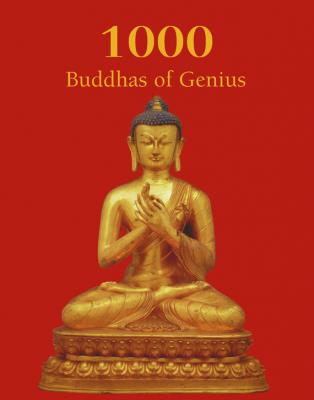1000 Buddhas of Genius. Victoria Charles
Читать онлайн.| Название | 1000 Buddhas of Genius |
|---|---|
| Автор произведения | Victoria Charles |
| Жанр | Энциклопедии |
| Серия | The Book |
| Издательство | Энциклопедии |
| Год выпуска | 0 |
| isbn | 978-1-78310-957-9, 978-1-78310-463-5 |
Throughout his career, Gautama was in the habit of travelling about during most of the fine part of the year, teaching and preaching to the people; but during the four rainy months, from June to October, he remained in one place devoting himself more particularly to the instruction of his declared followers.
72. Phra Bot (Buddhist temple banner) showing Sakyamuni Buddha with his two chief disciples, the monks Sariputra and Maudgalyayana, date unknown, location unknown, painting on cloth, 98 × 270 cm.
From the Pali Canon:
His teachings, always practical, include lessons in basic good manners:
“And how is a monk one with a sense of social gatherings? There is the case where a monk knows his social gathering: ‘This is a social gathering of noble warriors; this, a social gathering of priests; this, a social gathering of householders; this, a social gathering of contemplatives; here one should approach them in this way, stand in this way, act in this way, sit in this way, speak in this way, stay silent in this way.’ If he didn’t know his social gathering, he wouldn’t be said to be one with a sense of social gatherings. So it’s because he does know his social gathering that he is said to be one with a sense of social gatherings. This is one with a sense of Dharma, a sense of meaning, a sense of himself, a sense of moderation, a sense of time, and a sense of social gatherings.”
[AN VII.64]
…lessons in how to treat one’s parents:
Support for one’s parents,
assistance to one’s wife and children,
consistency in one’s work:
This is the highest protection.
[Sn II.4]
73. The Buddha Preaching His First Sermon, date unknown, Wat Palelai Temple, Singapore, carved, painted and gilded teakwood, 2.48 × 1.17 m.
Mother and father,
compassionate to their family,
are called
Brahma,
first teachers,
those worthy of gifts
from their children.
So the wise should pay them
homage,
honour
with food and drink
clothing and bedding
anointing and bathing
and washing their feet.
Performing these services to their parents, the wise
are praised right here
and after death
rejoice in heaven.
[Iti 106]
…lessons on the value of generosity:
“And what is the treasure of generosity? There is the case of a disciple of the noble ones, his awareness cleansed of the stain of stinginess, living at home, freely generous, openhanded, delighting in being magnanimous, responsive to requests, delighting in the distribution of alms. This is called the treasure of generosity.”
[AN VII.6]
74. Seated Buddha, date unknown, Wihan Nam Tam, Wat Phrathat Lampang Luang, Lampang Luang, Thailand, gilt bronze.
75. Seated Buddha, date unknown, Wat Na Praman, Ayutthaya, Thailand.
…on the value of virtue:
“And what is the treasure of virtue? There is the case where a disciple of the noble ones abstains from taking life, abstains from stealing, abstains from illicit sexual conduct, abstains from lying, abstains from taking intoxicants that cause heedlessness. This, monks, is called the treasure of virtue.”
[AN VII.6]
…on the fruits of virtuous conduct:
With mind rightly directed,
speaking right speech,
doing right deeds with the body:
a person here
of much learning,
a doer of merit
here in this life so short,
at the break-up of the body,
discerning,
reappears in heaven.
[Iti 71]
…on the drawbacks of all sensual pleasures – even heavenly ones:
“There is the case where a person, being subject himself to aging, realising the drawbacks of what is subject to aging, seeks the unaging, unsurpassed rest from the yoke: Unbinding. Being subject himself to illness, realising the drawbacks of what is subject to illness, he seeks the unailing, unsurpassed rest from the yoke: Unbinding. Being subject himself to death, realising the drawbacks of what is subject to death, he seeks the undying, unsurpassed rest from the yoke: Unbinding. Being subject himself to defilement, realising the drawbacks of what is subject to defilement, he seeks the undefiled, unsurpassed rest from the yoke: Unbinding.”
[AN IV.252]
76. Sanar Muni Buddha, date unknown, Kalamyo Pagoda, Mrauk U, Burma, gilt bronze.
77. Gautama Buddha seated in meditation on a lotus throne with a fiery mandorla, one of the emblems of his spiritual power, surround him, date unknown, Temple of Yongsu, Suwon, South Korea.
78. Prayer flags and a traditional colourful umbrella, the Buddhist symbol of protection, raised over a figure of Gautama Buddha reclining at the moment of parinirvana, date unknown, Kusinagara, deathplace of the Buddha, Northern India.
79. Semi-reclining Buddha in front of a stupa, date unknown, Burma.
…on the value of renunciation:
“Having seen the drawback of sensual pleasures, I pursued that theme; having understood the reward of renunciation, I familiarised myself with it. My heart leaped up at renunciation, grew confident, steadfast, and firm, seeing it as peace. Then, quite withdrawn from sensuality, withdrawn from unskilful qualities, I entered and remained in the first jhana: rapture and pleasure born from withdrawal, accompanied by directed thought and evaluation.”
[AN IX.41]
… and on the four Noble Truths:
“Bhikkhus, it is through not realising, through not penetrating the Four Noble Truths that this long course of birth and death has been passed through and undergone by me as well as by you. What are these four? They are the noble truth of Dukkha; the noble truth of the origin of Dukkha; the noble truth of the cessation of Dukkha; and the noble truth of the way to the cessation of Dukkha. But now, bhikkhus, that these have been realised and penetrated, cut off is the craving for existence, destroyed is that which leads to renewed becoming, and there is no fresh becoming.”
[DN 16]
